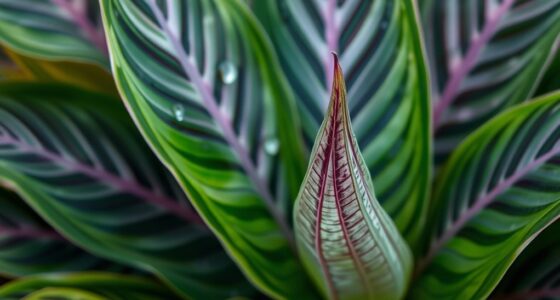To encourage your wax plant to flower indoors, make certain you water when the top inch of soil feels dry and use well-draining soil with drainage holes. Prune to remove unhealthy or leggy stems, which promotes bushier growth and more flowers. Keep the plant in bright, indirect light, and avoid overwatering or water pooling. Proper watering, pruning, and care will boost your hoya’s flowering potential—continue exploring these tips to help your plant thrive.
Key Takeaways
- Provide bright, indirect sunlight to encourage blooming and healthy growth.
- Maintain consistent watering, allowing the top inch of soil to dry out between waterings.
- Prune selectively to shape the plant and remove leggy or unhealthy stems, promoting more flowers.
- Use well-draining soil and ensure the pot has drainage holes to prevent root rot.
- Support flowering by keeping the plant in a warm environment and reducing fertilization during winter.

Hoya plants, known for their stunning, waxy foliage and fragrant clusters of flowers, are popular among indoor gardeners. To keep your hoya thriving and encourage those beautiful blooms, understanding their watering schedule and pruning techniques is vital. You want to strike the right balance, watering enough to keep the soil moist but not soggy, as overwatering can lead to root rot. Typically, you should water your hoya when the top inch of soil feels dry, which usually means every one to two weeks. During the active growing season, you might need to water a bit more often, while in winter, cut back to prevent overhydration. Always check the soil moisture before watering, and avoid letting the plant sit in excess water. Good drainage is key, so ensure your pot has drainage holes and use a well-draining soil mix to prevent water from pooling at the roots. Proper soil drainage is essential for healthy hoya growth and flowering.
Pruning techniques are equally important in maintaining a healthy hoya and promoting flowering. When you prune, focus on removing dead, damaged, or leggy stems to improve air circulation and shape the plant. Use clean, sharp scissors or pruning shears to make clean cuts just above a leaf node or where a stem meets another branch. This encourages new growth and can lead to more flowers in the future. If your hoya becomes overly leggy or sparse, you can prune back the longer vines to a node to encourage bushier growth. Remember, hoyas tend to bloom from old growth, so avoid excessive pruning that might remove potential flower buds. Regular pruning also prevents the plant from becoming too crowded, which can hinder airflow and increase the risk of pests or diseases.
In addition to pruning for shape and health, you can also propagate your hoya through stem cuttings. When taking cuttings, select healthy stems with a few leaves attached, and let the cut dry for a day before planting in fresh, well-draining soil. Keep the soil lightly moist and place the cutting in bright, indirect light until roots develop. Proper watering during this process is vital, as overly wet soil can cause rot, but too dry conditions may hinder root development.
Frequently Asked Questions
How Often Should I Repot My Hoya Plant?
You should repot your hoya plant every 2 to 3 years to manage its size and promote healthy growth. Keep an eye on the root system; if roots are circling or growing out of the drainage holes, it’s time to repot. During repotting, choose a slightly larger pot with good drainage, and refresh the soil to guarantee your hoya stays healthy and blooms beautifully indoors.
Can Hoya Plants Tolerate Direct Sunlight Indoors?
Imagine sunlight spilling through your window, casting a warm glow on your hoya plant. Yes, hoya plants can tolerate direct sunlight indoors, but they prefer bright, indirect light for ideal growth. Too much direct sun might scorch their leaves, so make sure they get plenty of natural light while avoiding harsh afternoon rays. Adjusting indoor light conditions helps your hoya thrive, producing those beautiful waxy flowers you love.
What Pests Commonly Affect Hoya Plants Indoors?
You might find common pests like mealybugs, spider mites, and aphids affecting your hoya plants indoors. These pests can cause damage by sucking sap or spreading disease. To prevent them, regularly inspect your plant, keep leaves clean, and avoid overwatering. Pest prevention includes isolating new plants and using natural treatments like neem oil or insecticidal soap. Prompt action keeps your hoya healthy and pest-free.
How Do I Encourage My Hoya to Bloom More Frequently?
Don’t worry if your hoya isn’t blooming as often as you’d like; with the right bloom encouragement, you’ll see results. Focus on fertilizer timing by using a balanced, diluted fertilizer during the growing season, typically spring and summer. Regularly pruning and providing bright, indirect light also stimulate flowering. Patience is key—consistent care and proper nutrition will encourage your hoya to bloom more frequently over time.
Is It Safe to Use Household Fertilizers on Hoya Plants?
Yes, using household fertilizer can be safe for your hoya if you choose the right type and follow instructions carefully. Always dilute the fertilizer to prevent overfeeding, which can harm your plant. Check the label for plant safety information and avoid products with high nitrogen levels or harsh chemicals. Using a balanced, diluted household fertilizer occasionally provides essential nutrients, promoting healthy growth and flowering without risking damage to your hoya.
Conclusion
Caring for your wax plant indoors not only brings beautiful blooms into your space but also adds a touch of coincidence—like finding a hidden gem in your own home. With just a little attention, you’ll find that your hoya rewards you with stunning flowers when you least expect it. So, keep nurturing your plant, and enjoy the surprise moments that make indoor gardening so rewarding. After all, sometimes beauty blooms when you’re not even looking.









